Sci-Fi & Fantasy Models
Sci-Fi & Fantasy Models #39 (September 1999), p22-32. Phil Rae wrote an earlier version of this article for the Nick Tate club, which was reprinted in Supermarionation Is Go! issue 1 (Spring 1981).
Phil Rae examines the Eagle, Hawk and Moon Buggy miniatures created for the series
Anderson collector Phil Rae has had first hand access to many of the original miniature spacecraft seen in Space:1999 for some time, and currently owns an original forty-four inch Eagle, a twenty-two inch Eagle, thirty-two and sixteen inch Hawk models and the 1/24th (44 inch Eagle scale) model of the Moon Buggy. Who better, then, to comment on the design, construction and filming of these classic TV miniatures?
The Eagle was, and is, a superb design- a wonderful, insect- like, gritty piece of hardware. Inspired, I suspect, by the designs of the Gemini and the Lunar Module spacecraft created for the NASA space programme, the Space:1999 Eagle was designed by 1999 series Special Effects Supervisor Brian Johnson as the 'Modular Transportation Unit (M.T.U.).
The three main Eagle miniatures for the first season of the show were built by Space Models of Feltham, (formerly Industrial And General Modelmakers) a company that had previously supplied models for various Gerry Anderson puppet series such as Stingray and Thunderbirds.
During early episodes of the first season the FX crew worked with one forty-four inch Eagle, one twenty-two inch Eagle and one eleven inch Eagle. Later in the season a small, less detailed, five and a half inch version was built by Martin Bower for use in a long shot in the episode Collision Course and a second forty-four inch Eagle was commissioned (also built by Space Models).
The difference between the two forty-four inch models lay primarily in the first Eagle having a perspex 'beak', whilst the second one was moulded in fibreglass. However, this second forty-four Eagle was subsequently redressed and repainted and its surface detailing changed significantly (possibly because the studio felt the two Eagles should be distinguishable when compared).
During the second season the studio also added a third forty- four inch model to their fleet, which was built by Derek Freeborne Associates and turned out a little different to the other two large Eagles because of its diverse pedigree. The overall shape was pretty much the same, although the model exhibited many subtle differences in terms of the shape of the nose cone, design of the foot pads, pod, etc.
There was also a second twenty-two inch Eagle built for the second season by Martin Bower, which was noticeably used in the two-parter Bringers Of Wonder. A second eleven inch Eagle appears to also have been created for the second season, but I'm not sure if this was ever used. The foot pads from this model were actually taken from the Airfix/MPC model kit and some of the framework was made using EMA rather than brass. The difference between this and the original model to this scale is quite noticeable.
The original twenty-two inch Eagle is considerably less detailed than its larger counterpart. Many of the surface model kit parts that appear on the forty-four inch model are not reproduced on the original twenty- two inch version. Neither, for example, are the 'elbow joints' on the back of the foot pads, so, plainly, the forty-four inch Eagle was intended for use in close-up shots and the twenty-two inch models only for longer shots. However, I guess, because the forty-four inch Eagle weighs 'a ton' (in actuality probably around sixty pounds), it is the case that the twenty- two inch Eagle got a lot of exposure on screen, some of it quite close up, its lighter construction making it far easier to 'fly' than its larger, heftier brother.
The forty-four inch Eagle is very sturdily built. The nose section on the Eagle I own is moulded from perspex (plexiglass); all the framework is made from soldered brass and the leg pods are solid wood covered in perspex.
The foot pads are perspex, steel and brass, the pods are perspex and all the engine bells are aluminium, so it's a pretty solid, heavy miniature. Inside the pod is a cavity which the EX crew used to hide the freon gas canisters (air brush propellant) and the electric control solenoids needed to produce the gas jet effect seen in certain episodes. I suspect that, when this effect was first devised, the intention was to purely provide an internal source of air to kick up dust around the model's feet. I think it was then discovered, possibly by chance, that if you turn a freon gas canister on its side, or upside down, you actually get a stream of vapour, which you can sometimes see jetting out from underneath the Eagles. In the second season the crew added freon gas jet tubes and nozzles to the engines at the back- in the first episode The Metamorph you can see all four main engines firing at the rear. It's interesting to note that, during the first season, the jet effect glow on the main engines was added using special effects- in many cases by hand painting the individual film negative.
There's a myth that the Eagle models were altered only for the series' second season, with pods being beefed up, etc. There is what is sometimes called a 'laboratory pod', and this does get an airing more often in the second season, but it was actually built during the first season. It only appears in a few shots and, from the point of view of functional design, was possibly conceived to eliminate the ludicrous sequences, filmed earlier in the series, in which Eagles can be seen docking with each other, a manoeuvre during which the thrusters on the sides of the leg pods would inevitably have tangled and collided. Whilst featured, the laboratory pod wasn't, however, used very much in the first season.
During the second season designs for strap-on boosters for the top and sides of the Eagle were introduced. In The Rules of Luton it is noticeable that the side boosters only appear on one side of the model and, incidentally, had engine bells that were cannibalised from the spaceship built for the first- season episode Death's Other Dominion.
Quite a number of recognisable kit parts are to be found on the large Eagle including bits from Airfix Saturn 5 and 1/24 scale Revell Gemini kits- in fact the figures in the cockpit are Gemini figures- plus many obscure tank kit parts and lots of EMA domes and other components.
Although the twenty-two and forty-four inch Eagles had hollow nose cones, the interiors of these were sparsely detailed. However, at least one of the forty-four inch miniatures had practical lighting. The interior cockpit areas were never featured in any close-up work although, as mentioned, there are actually figures in the forty-four inch cockpit, which don't really show up. Each time you see 'people' behind the cockpit windows on the show they were inserted as a special effect using real actors.
Although the whole of the main engines unit and nose cone sections (with their immediate surrounding structure) were designed to detach, (as do the leg pods) these options were never used in the show. Whilst a beak (without surrounding structure) does detach in the first season episode Dragon's Domain, I suspect that maybe the model makers were originally told that this was to be a modular spaceship and all the parts should therefore be interchangeable to enable sections of a different design to be added for other functions. It's also likely that this interchangeability was simply to permit the convenient swapping of different parts of the models for damaged sections, which do appear in the show from time to time. In any event, these opportunities were never fully realised.
Another interesting design element lies in the form of the Eagle's landing gear, in that the shape of the foot pad mirrors the shape of the cut out on the underside of the leg pod. I feel that, as originally conceived, the foot pad was perhaps intended to fully retract up into the bottom of the leg pod. It does actually appear that way in the American Carlton comics, and there was even artwork in the British magazine Look-In which showed the foot pads retracted, but this was never seen to happen on screen. From the point of view of the miniatures, if you actually measure the profile of the foot pad and then measure the recess, they don't match exactly. This doesn't mean to say they didn't fit exactly when they were first built as the Eagles were often crashed and I guess the original foot pads may have been replaced at some stage during filming.
In any event, since the side pods were made from solid wood, the models were not built to allow the foot pad to retract. It's possible that it was considered too expensive to do or the idea could just be a functional concept interpolated incorrectly by the comic artists.
Although the forty-four inch Eagles were the largest 'complete' models of this craft built, certain sections were built to a larger scale, most notably a large scale version of one of the leg pods, which was wildly different from those seen on the complete models. There were also various sections of girder work constructed for special close up shots, including the deployment of the Eagle laser cannon and a scene requiring a spacewalk. Nothing of the Eagle's exterior was built full size and I recall that a number of people reportedly expressed disappointment that there wasn't a one to one Eagle on display at the Blackpool Gerry Anderson exhibition in the late seventies. They were convinced there must have been one as they had seen people inside it and walking out of it on the show!
The Eagle miniatures were finished with car spray paint and, when delivered from the model makers to the studios, the models would have been pristine white. All subsequent dirtying down and panelling was carried out at the studios by the 'in house' team of model makers, headed by Terry Reid. The Alpha logos on the Eagle models were custom made waterslide decals. Panel lines were added using a pen or pencil, with contrast panels being masked and spray painted. Weathering was primarily carefully applied using an airbrush, but the subtlety of this, whilst evident in contemporary stills, is somewhat lost on screen.
All the Eagles were equipped with several different pod types, (with the exception of the five and a half inch version). They also had various 'add-ons', such as the grabs used in The Exiles and Collision Course.
Winch gear assemblies for the 'freighter' modules were made in the three largest scales for the first episode Breakaway. It's worthy of note that the forty-four inch version's gear must have followed the twenty- two inch version in construction order. The evidence for this is that, upon examination, it is apparent that most of the smaller version of the winch is made from Airfix Saturn 5 and Gemini kit parts which were quite closely reproduced at twice the size for the forty-four inch version.
In one shot in Earthbound or Breakaway, Commissioner Simmonds' Eagle is seen sporting an orange pod. This was created by hand tinting the pod section on stock footage- an actual orange painted pod model was never produced! We now know this is false; at least the 22 inch and 11 inch Eagles had orange pods
The pods on the forty-four and twenty-two inch Eagles are held in place with simple screws. On models fixings are often made as simple as possible, on the (correct) assumption that these things aren't going to show on screen. The underside panel of the pods used on the forty-four inch models is likewise simply screwed into place to permit easy access to change the freon gas canisters inside. Many things in science fiction film making are often a compromise of art against science. Consider the shape of the Eagle's beak, compared to the shape of the full-size cockpit set, as an example. Gemini figures at 1/24 scale were used in the in the forty-four inch miniature's cockpit. These are, in fact, too large relative to the full size set. The small Moon Buggy, which supposedly scales with the Eagle, uses the Gemini figures too, but this model is wider than the Eagle pod doorway. The scale relative to a 'real' vehicle is compromised by the fact that they chose to use ready- made figures. I calculate that the 'true' scale of the forty-four inch Eagle model is around 1/35. I also suspect that, when the Eagle miniatures were commissioned, the size of the completed ship was more of an issue than the scale.
As another example of artistic licence in scaling, it is noted that behind the nose cone on some of the models is a doorway (moulded in the front of the main body) which follows the curving profile of the back of the beak. This is nothing like the shape of the door on the full-size cockpit set. Of course, the full- size Eagle cockpit is, generally speaking, clearly a different shape than its miniature counterpart. It is clear that, within the context of futuristic design for television, choosing aesthetically pleasing forms that work together is extremely difficult.
The Hawk miniatures seen in the episode War Games were again designed by Brian Johnson. His design was later interpreted by series model maker Martin Bower, who was commissioned to build two models in scale with the forty-four and twenty- two inch Eagles. The Hawk concept is apparently that of an attack version of the Eagle, and the design similarities are obvious and deliberate. When the models arrived at the studio they were completely white. The orange contrast colour was added there (presumably because the studio felt the models looked too much like Eagles). The big version, some thirty-two inches long, features a vacuformed nose cone and is otherwise made from perspex, wood, model kit and other scavenged parts, including a main body made up of Airfix Saturn 1B and Saturn 5 rocket pieces. This version features a little pea bulb on the front underside for special effects footage of the craft's 'laser gun'. The smaller Hawk is similar in construction and measures some sixteen inches long. There was, in fact, also a very small and very basic version built at the studio from wood and plastic parts that was used in shots where the Hawks are accompanying the huge space bomber. This was about four inches in length.
The Moon Buggy was procured as a full size prop in the first instance and was essentially a commercial amphibious vehicle which the studio repainted and redressed. The same buggy appears in the '60s US TV show The Banana Splits. Miniature versions of the vehicle were built to several different scales from fibreglass or perspex and suitably sized off the shelf figures were modified to travel aboard. The largest of the miniature buggies was around quarter scale and was battery operated. In conjunction with this version, foam latex astronaut figures with simple wire armatures were custom made to sit in it. The wheels on this version were also made of foam latex.
When filming the miniatures the FX crew would generally mount the camera on tracks and pan it past the Eagle or Hawk or whatever spaceship was being shot. The relevant model would be mounted on a pole covered in black velvet in what was, I guess, an early form of motion control. Other shots of the Eagles featured the models being traditionally flown on wires. Photographic cut outs of the models were also extensively used. Star fields were usually placed outside of the flight path of the model to avoid doing matte shots.
In underground hangar scenes which feature great numbers of Eagles all lined up, simple photographic cut-outs of the craft were used. This generally worked well for filming purposes, but the illusion is sometimes not all that convincing in publicity stills taken at angles other than those of the camera. I suspect the reason they had the third large scale Eagle made was because earlier shots, requiring a number of forty-four inch Eagles in shot together, were sometimes compromised by the fact that they'd had to use photographic cut-outs, and this sometimes showed.
Photographic cut outs were also extensively used where models had to be blown up. For these scenes of destruction the original model would be filmed sitting on the set or hanging from wires then a cut would be made to footage of an explosion taking place behind a photographic cut out of the model. The pyrotechnic package was often filled with model debris and filmed looking up at the explosion so that it would appear to expand in all directions simulating gravity conditions.
Space: 1999's special effects may not all stand up to close scrutiny compared to what is on offer today, but at the time they were considerably more sophisticated than anything else that was appearing on television, and certainly as good as most things seen in the cinema back in 1975. All credit is due to the designers and technicians for their innovation and ingenuity in setting new standards for others to follow.
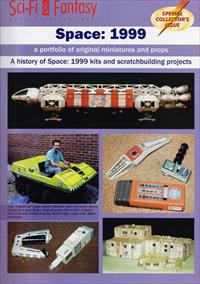
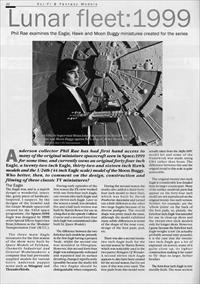
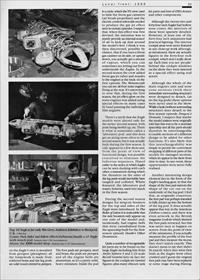
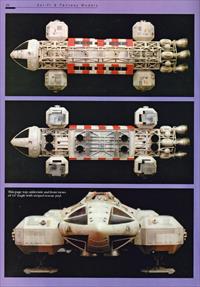
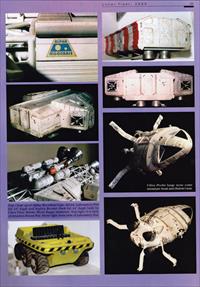
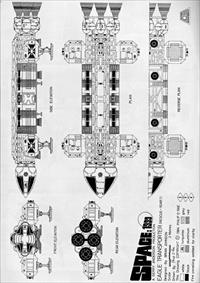
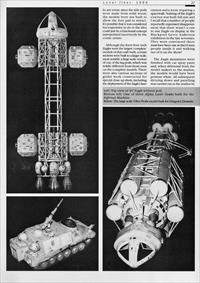
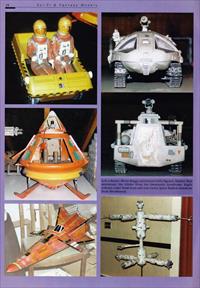
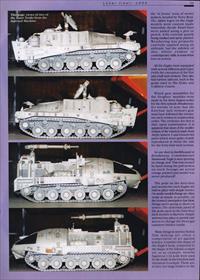
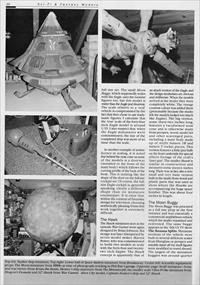
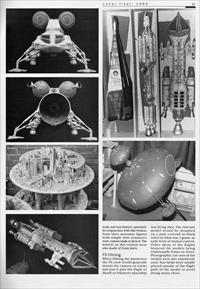
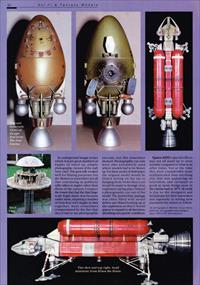
Photographs copyright Phil Rae/ ITC
Space:1999 Copyright ITC Entertainment Group Ltd.